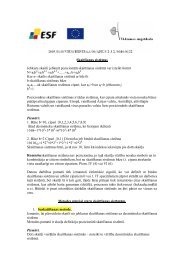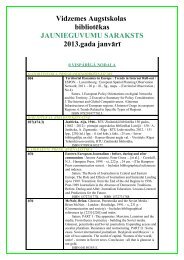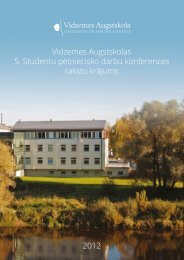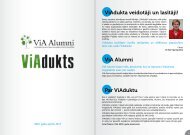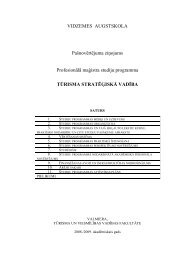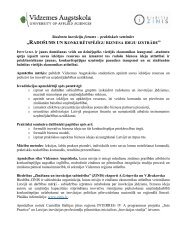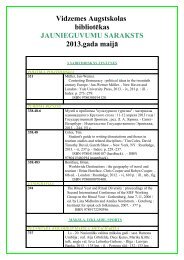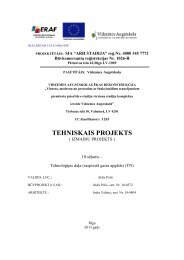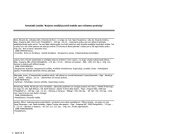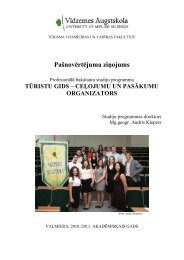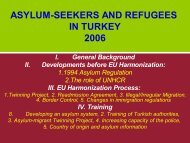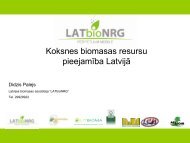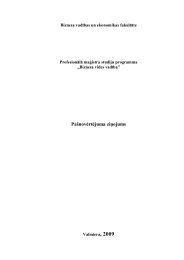Proceedings
Proceedings
Proceedings
You also want an ePaper? Increase the reach of your titles
YUMPU automatically turns print PDFs into web optimized ePapers that Google loves.
Sustainable Planning Instruments and Biodiversity Conservation<br />
Sustainable Development and Encouragement of Environmentally Friendly Branches in the Latvian National Economy<br />
Number of facilities<br />
European Commission about these industries. The<br />
European industry branches that exceed the defined<br />
quantity are shown in Figure 4.<br />
The greatest numbers of companies that exceed<br />
pollution limits are in Rīga, Daugavpils and Liepāja.<br />
5 Concluding Remarks<br />
Based on the research carried out, the following main<br />
conclusions are drawn.<br />
1. Results of the research are connected with the<br />
investigation and improvement of the methods for<br />
economic evaluation of environmental pollution in<br />
order to apply them at enterprises and organizations,<br />
with developing economic-mathematical models and<br />
adjusting them to real planning of environmental<br />
protection activities and including them into strategic<br />
plans as well as in investment projects. From the<br />
economics point of view, it would be correct to choose<br />
that kind of resources’ utilization that would permit<br />
achieving the highest effectiveness.<br />
2. The structure of environmental pollution in Latvia<br />
depends on the structure of the national economy<br />
branches. It is complicated to choose the best method<br />
12<br />
3000<br />
2500<br />
2000<br />
1500<br />
1000<br />
500<br />
0<br />
895<br />
Combustion<br />
174<br />
Refineries<br />
Coke ovens<br />
17 15<br />
Coal plants<br />
825<br />
688 669<br />
Metal industry<br />
325<br />
34<br />
118<br />
328<br />
Activity<br />
Figure 4. Categories whose pollution limits are exceeded in Europe<br />
Cement, clinker, lime mineral<br />
Organic chemicals<br />
Inorganic chemicals<br />
Biocides and explosives<br />
Pharmaceuticals<br />
Hazardous/municipal waste<br />
908<br />
Nonhazardous waste/landfills<br />
402<br />
Pulp and paper<br />
131 26<br />
643<br />
Textiles<br />
Tanning<br />
Slaughterhouses, milk production<br />
for the evaluation of pollution created by economic<br />
activities, because due to unjustified, frequent changes<br />
in the requirements of legislation, the data structure<br />
(accounting and information) necessary for modeling<br />
also changes. The economic situation of Latvia is still<br />
in the stage of transmission from traditional economy<br />
to sustainable economy.<br />
3. Pollution and its increase depends on three main<br />
factors – the total number of population, welfare of<br />
society and devising and use of various technologies.<br />
Pollution development (direction) cannot always be<br />
measured. The increase in resource consumption<br />
is not necessarily needed for economic growth, as<br />
the same and even better results can be achieved<br />
by a more useful utilization of resources, including<br />
restructuring of branches, recycling of resources and<br />
introduction of environmental protection activities.<br />
4. There are problems with the various interpretations<br />
of the definition of sustainable development. Very<br />
often sustainable development is talked about as a<br />
totality of environmental protection activities only,<br />
or equal development of the regions and the centre,<br />
or sustainable development of the territory, or<br />
development of the national economy (sustainable<br />
21<br />
Animal waste<br />
2801<br />
Poultry and pigs<br />
346<br />
Surface treatment<br />
11<br />
Carbon<br />
growth, sustainable production development). It is<br />
necessary to use a common explanation of the term,<br />
which has been written into the law “On Environment<br />
Protection”: “sustainable development – integral<br />
and balanced development of society welfare, the<br />
environment and economy that satisfies the current<br />
social and economic needs of the population and<br />
permits observing requirements of environmental<br />
protection without endangering possibilities to satisfy<br />
the needs of future generations, as well as ensures<br />
preservation of biological diversity”.<br />
5. Economic activities always leave an impact on<br />
the environment. The strategy of sustainable<br />
development is based on the dematerialization<br />
conception – provision of a certain welfare level, at<br />
the same time reducing material consumption needs<br />
and resource consumption. Latvia as a European<br />
Union Member State has a duty to implement<br />
policies that provide sustainable development<br />
principles, but the government, in its turn, has to<br />
ensure implementation monitoring. Environmentally<br />
friendly economic activities have to be grounded on<br />
calculations of expenditures – benefits – resource<br />
consumption, and other calculations.<br />
Summarizing the conclusions of the research work,<br />
the author makes the following proposals.<br />
1. A national-level inventory is needed in order to<br />
ascertain current pollution, to acknowledge the<br />
possible pollution and to provide preventive activities.<br />
The classification of the polluted places is provided<br />
in the law “On Pollution”, but there is no instrument<br />
which would force municipalities to get involved<br />
and provide information. Therefore, the government<br />
should ensure the collection of relevant information<br />
and make it accessible for the society at large.<br />
2. Society lacks understanding about types of pollution,<br />
its amount and consequences. There is lack of<br />
information about particular branch pollution and<br />
possible risks; therefore, the Regional Boards of the<br />
State Environmental Inspectorate have to publish lists<br />
of the enterprises and organizations which have been<br />
notified about polluting activities, corresponding<br />
to the Cabinet of Ministers Regulations No. 294 of<br />
July 9, 2002, “Regulations on the procedure for the<br />
notification of category A, B and C polluting activities<br />
and issuing category A and B permits”.<br />
3. In calculations made for fostering development of<br />
environmentally friendly branches, the structural<br />
changes theory by economists A. C. Fisher and C. W.<br />
Clark, as well as V. Leontjevs’ inter-industry balance<br />
mathematical model, should be used for adjusting<br />
the economic instruments on the national level, for<br />
instance, for working out a more flexible tax policy.<br />
4. Municipalities should organize informative,<br />
explanatory and educative seminars and discussions,<br />
where the society on a broader scale would be able<br />
to clarify information about economic activities in<br />
the municipality’s territory and its impact on the<br />
environment, as well as provide free consultations for<br />
the population with the help of e-environment.<br />
5. Analyzing the impact of the EU structural funds on<br />
the Latvian environment infrastructure development,<br />
it is useful to evaluate the economic effectiveness of<br />
investments of the projects, including calculations of<br />
the economic effect of the treatment of environment.<br />
As an obligatory requirement for the economic<br />
grounds of investment projects, repayment time<br />
and expenditure base of environmental protection<br />
activities should be introduced.<br />
References<br />
1. Atstāja D. Economic assessment of environment pollution<br />
created by economic activities in Latvia. Summary<br />
of Doctoral Dissertation. R: RTU, 2008. 42 p. ISBN 978-<br />
9984-32-855-3<br />
2. Arhipova I., Bāliņa S. Statistika ekonomikā. Risinājumi ar<br />
SPSS un Microsoft Excel. Rīga: Datorzinību centrs, 2003.,<br />
352 lpp. ISBN 0084-665-19-4<br />
3. Frolova L. Matemātiskā modelēšana ekonomikā un<br />
menedžmentā. Teorija un prakse. Rīga: SIA JUMI, 2005.,<br />
438 lpp. ISBN 9984-617-64-5<br />
4. Latvijas Izmaksu – izlaides tabulas 1997. Rīga: Latvijas<br />
Republikas Centrālā Statistikas pārvalde, 2001., 287 lpp.<br />
ISBN 9984-06-114-0<br />
5. Barry C. Field, Martha K. Field. Environmental economics:<br />
an introduction. Third Edition, NY: McGraw-Hill<br />
Companies, 2002, p. 510. ISBN 0-07-242921-6<br />
6. EPER, The European Pollutant Emission Register. http://<br />
www.eper.cec.eu.int/eper/default.asp<br />
7. Perman R., Ma Y., McGilvray J., Common M. Natural<br />
Resource and Environmental Economics. Third Edition,<br />
London: Pearson Education Limited, 2003, p. 699. ISBN<br />
0273655590.<br />
8. Tietenberg T. Environmental Economics & Policy, 5 th edition.<br />
Pearson Addison-Wesley, 2007, p. 537.<br />
9. The History of Economic Thought. http://homepage.<br />
newschool.edu/het/<br />
10. The world factbook. Field Listing – GDP – composition by<br />
sector GDP – composition by sector (%). http://www.cia.<br />
gov/cia/publications/factbook/fields/2012.html<br />
13



